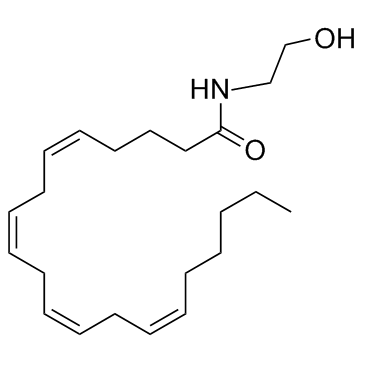Anandamide (Synonyms: AEA, Anandamide) |
| Katalog-Nr.GC35339 |
An immune modulator in the central nervous system
Products are for research use only. Not for human use. We do not sell to patients.

Cas No.: 94421-68-8
Sample solution is provided at 25 µL, 10mM.
Anandamide is an immune modulator in the central nervous system acts via not only cannabinoid receptors (CB1 and CB2) but also other targets (e.g., GPR18/GPR55). CB1 CB2 GPR18/GPR55 Human Endogenous Metabolite
Anandamide, acting via CB2 receptors, alleviates lipopolysaccharide (LPS)-induced neuroinflammation in rat primary microglial cultures. The endocannabinoid system modulates both neuronal and immune functions through two protein-coupled cannabinoid receptors (CB1 and CB2), although endocannabinoids, especially Anandamide (AEA), can activate numerous other receptors like PPARS, TRPV1, and GPR18/GPR55[1].
Anandamide is an endocannabinoid binding both CB1R and CB2R. To evaluate the impact of CBR activation on whole-body glucose homeostasis, glucose tolerance is assessed after a single intraperitoneal Anandamide injection (10 mg/kg). The increase in glycemia in response to glucose ingestion is considerably smaller in mice treated with Anandamide compared with control, and this is associated with an improvement of glucose tolerance as illustrated by the AUC0-2h calculations[2].
[1]. Malek N, et al. Anandamide, Acting via CB2 Receptors, Alleviates LPS-Induced Neuroinflammation in Rat Primary Microglial Cultures. Neural Plast. 2015;2015:130639. [2]. Troy-Fioramonti S, et al. Acute activation of cannabinoid receptors by Anandamide reduces gastrointestinal motility and improves postprandial glycemia in mice. Diabetes. 2015 Mar;64(3):808-18.
Average Rating: 5 (Based on Reviews and 21 reference(s) in Google Scholar.)
GLPBIO products are for RESEARCH USE ONLY. Please make sure your review or question is research based.
Required fields are marked with *




